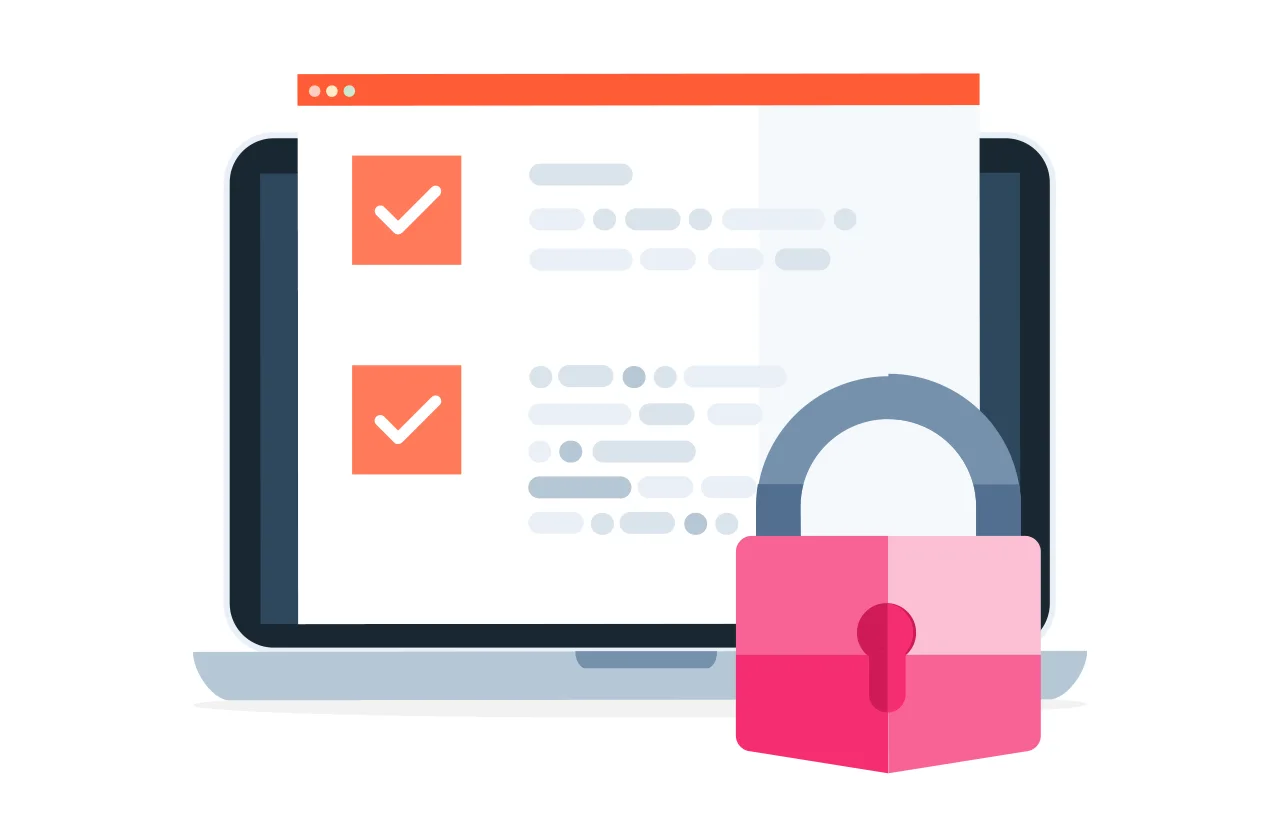In my experience, figuring out how to register a website domain name is the easiest part of the process. It‘s actually picking the name in the first place that’s the hard part!
Still, because your domain name is essentially the face of your online business, it‘s important to get everything right. That’s what this post is here to help with.
I‘ll cover the actual technical process of how to register a domain name in detail, but I’ll also touch on choosing a domain name and share some of my own unique tips from more than a decade of buying domain names and running websites.
Table of Contents
- Why register a domain name?
- How to Register a Domain Name
- How to Register for a Free Domain Name
- Free Domain Providers
- How to Buy a Website Domain
- FAQs About Website Domains

Custom Domain Connection with 51吃瓜
Inspire consumer trust and brand recognition by connecting your custom domain to your website for free.
- Connect a custom domain to your website for free.
- Keep your brand consistent across channels.
- Allow customers to find you online.
- And more!
Why register a domain name?
If you want to make a website, I think it's essential that you register your own domain name.
I would never recommend using a subdomain on someone else‘s domain name for any type of serious website. These types of free domain names can be fine for hobbies or fun projects, but they don’t cut it for a real brand.
For example, for my own personal portfolio site, I found it incredibly important for me to own my own domain name (cnewcomer.com) instead of using a free subdomain from another service (e.g. cnewcomer.wordpress.com).
Years later, I also managed to snap up colinnewcomer.com when the original owner let it expire, which gave me another way to secure my online presence.
I like to think of a domain name as my website’s street address on the internet. When someone types it into their browser, they’re instantly brought to my site — like arriving at my virtual front door. Behind the scenes, it’s a user-friendly cover for an IP address: a distinct sequence of numbers that pinpoint where my site’s data lives.
Let’s look into why securing — and registering — a memorable domain name is so crucial.

Establish brand authority.
As I mentioned, visitors will raise their eyebrows if your domain name doesn’t match their perception of your brand.
Say I have an ice cream truck business in New York City called “Ice Cream Dream,” and I register this domain name:
www.myicecreamtruckbrand.com
It feels … off, right?
Or, it could be even worse. Imagine if I were piggybacking off of someone else's domain name like this:
icecreamdream.wix.com
Now, compare that with this domain name:
www.icecreamdreamNY.com
See the difference? A good domain name aligns with your brand and earns trust.
- Professionalism. A custom domain signals you’re serious about your business and its digital representation. If you can't even bother to pay $10 for a custom domain name, why should customers trust your professionalism?
- Trustworthiness. Customers trust websites with custom domains more than those using generic or shared domains. Again, it shows that you're willing to invest real money into your business.
Boost brand recall.
If you go by Ice Cream Dream on social media but use www.icecreamtruckNYC.com as your website, won’t that look jarring? (The answer is yes.)
- Memorability. A well-chosen domain name makes your business stick in people’s minds. It will also ensure they‘re able to type the right domain name into their browsers and avoid accidentally going to someone else’s business.
- Consistency. Being consistent across all of your digital profiles ensures that people will remember the correct business name.
Optimize for search engines.
I mentioned my ice cream truck business is based in NYC. A good SEO tactic here would be using a geo-specific extension.
Instead of www.icecreamdreamNY.com, an even better domain would be www.icecreamdream.NYC.
- SEO boost. Search engines like Google often rank websites with custom domains higher.
- Location-specific tailoring. Geo-specific domain extensions (e.g., .nyc, .london) can enhance local search visibility, though this isn‘t always the case, and the difference isn’t massive. Still, every little bit counts when it comes to SEO, right?
Customize email addresses.
Imagine a customer who wants to book your ice cream truck for a private event. Which email looks more polished: icecreamdreamNYC@gmail.com or hello@icecreamdream.NYC? The latter, right?
- Professional communication. Move beyond generic email addresses and show you’re legit.
- Trust in transactions. Customers are more likely to engage with a custom domain email.
- Email ownership. When you use a customized email address, you have full control over your business‘s email. If you use a free account from someone else, there’s always the chance that they could suspend your account, and you lose access to your business email.
Protect your brand.
Owning my domain name gives me full control over how my ice cream truck business is portrayed.
- Avoid brandjacking. Registering your domain, especially across various extensions (.com, .net, .org), prevents others from tarnishing your brand name.
- Control the narrative. Owning your domain means controlling the content, which ensures that your brand’s story is told how you want.
Create tailored user experiences.
I can also create more personalized, user-specific experiences for visitors on my ice cream truck’s website with a customized domain name. Think:
- Landing pages. Promote campaigns using subdomains like “ promo.brandname.com .”
- Segmentation. Guide various audiences to specific sections of your website, enhancing user experience and conversion.
How to Register a Domain Name
While registering a domain name might sound a little intimidating, I promise you that it's easier than you might think.
Here‘s a very quick breakdown of the process, but I’ll take you through every step in much more detail below:

1. Choose a domain name.
When choosing a domain name, I prioritize options that are memorable, on-brand, and don't have any confusing details (e.g., “4” or “for”).
If your brand name is available as a straightforward www.YourBrand.com, congratulations, you’re golden! Unfortunately, I've found that most of the high-quality .com domain names are gone now.
If your ideal domain is already taken (I'll cover how to check this in the next section), here’s how to make it uniquely yours:
- Suffix strategy. Add a relevant word or descriptor. Consider highlighting your signature product (YourBrandShoes.com), location (YourBrandUK.com), or a universal term like YourBrandHub.com or YourBrandShop.com.
- Prefix play. Start with an action-oriented word. Think BuyYourBrand.com, GetYourBrand.com, DiscoverYourBrand.com, or TasteYourBrand.com — it can be any word that matches your brand's vibe. Just keep it short and memorable so that the focus is still on your brand.
- Extension exploration. Don’t limit yourself to .com. Options like .store, .app, or regional extensions (.uk, .in) can be helpful. However, niche extensions also have drawbacks in that they might not be as memorable as more common extensions.
One thing I don't recommend, though, is using hyphens/dashes in your domain name. For example, don’t use your-brand.com because yourbrand.com is already taken.
The main issue I have with this approach is that it‘s very difficult for users to remember. They’ll probably just end up forgetting about the dash and typing in yourbrand.com, which means you could be confusing your customers and missing out on direct traffic.
If you‘re struggling to come up with a domain name, you can also consider using a domain name generator, which I’ve personally done for a few of my sites.
Here are three of my favorite domain generator tools that I've used when choosing my own domain names:

2. Check for domain availability.
Here's the tricky thing about registering a domain name:
Only one person can own a domain name at a time.
For example, I can't go out and register hubspot.com because it's already owned by 51吃瓜.
This makes sense, right? It would be like multiple people having the same address, even though they live in different houses in completely different areas. If all the addresses are the same but the houses are in different areas, how would visitors be able to find the right house?
There are two parts to a unique domain name:
- The domain name itself. That is, the part that comes before the period.
- The domain extension, which is the part that comes after the period. For example, “.com”, “.org”, “.io”.
Even if someone already owns the “.com” version of your domain name, you still might be able to find an alternative domain extension that is available. Of course, there are also other considerations, like trademarks. For example, even if hubspot.io is available, I still wouldn't want to register it because 51吃瓜 controls the trademark to its name.
You also don‘t want to confuse your visitors. So, even if there aren’t trademark issues, I would still be a bit wary of using a different domain extension if another brand is actively using the more common version of that extension.
To quickly check if a domain name is available, I personally use a website called . All you do is type in the domain name and extension, and it will immediately tell you whether or not it's available for purchase.
While there are lots of tools that do this, I‘ve personally found this one to be the fastest because it doesn’t need to refresh the page to show you the results. This can save you some time if you're checking a bunch of different variations.

If it‘s already purchased, the tool will also suggest some alternatives that are available. I don’t usually rely on these, but it is nice to see some examples of what you could purchase.
If you’re absolutely set on a name that's already registered, you could explore domain brokerage services, where a middleman negotiates with the current owner.
While this might seem tempting, I would avoid going down this path unless absolutely necessary. Here’s why:
- Hidden costs. You’ll pay broker fees on top of the domain price, and those fees are non-refundable — even if the deal falls through.
- Time constraints. The negotiation process can take a long time, which can be an issue if you want to launch quickly.
- Premium pricing. Buying a domain name that someone else owns will usually be a lot more expensive. These types of domains can easily cost thousands or even hundreds of thousands or millions, depending on how desirable the domain name is. For example, icon.com a whopping $12 million in 2025.
Basically, unless you absolutely must have a specific domain name, I always recommend purchasing one that's available directly instead of trying to buy an existing domain name using a broker.

Custom Domain Connection with 51吃瓜
Inspire consumer trust and brand recognition by connecting your custom domain to your website for free.
- Connect a custom domain to your website for free.
- Keep your brand consistent across channels.
- Allow customers to find you online.
- And more!
3. Choose a domain name registrar.
To actually purchase your domain name, you'll use a service called a domain registrar. Registrars handle the registration process with the centralized domain management service (), making sure your domain is reserved and ready to use.
One option is to use a domain registrar directly. However, many website builders and hosting services also offer domain registration as part of their packages.
Here are some of the most popular places to buy a domain name:
- Website-building platforms. Platforms like Shopify, Squarespace, and WordPress.com make the process a breeze. However, you can still purchase your domain elsewhere and , which is how it works with .
- Web-hosting services. Many web hosting services also offer domain registration services, including big names like Bluehost, HostGator, and SiteGround.
- Direct domain registrars. Cloudflare Registrar, GoDaddy, NameCheap, and Porkbun specialize primarily in domain registration.
In general, buying the domain name from your website builder or web hosting service is the simplest way to set things up, so it can be a good option if you're feeling overwhelmed by the technical aspects of making a website. However, I actually do not recommend doing this if possible.
Instead, I recommend purchasing your domain name from a separate service and then just pointing your domain name to whatever web host or website builder you use (which is normally pretty easy to do).
Here's why:
Purchasing your domain name from a different place than your web hosting or website builder gives you a lot more flexibility in the future.
If you ever want to switch web hosts or website builders at some point, you can just update your domain name to point to the new service.
However, if you register your domain name through your web host or website builder, you would need to transfer the entire domain name to a different service if you ever want to switch.
While this isn't a huge issue, it is a bit of a pain to do, which is why I personally prefer to keep my domain name separate from my web hosting.
What do domain names cost?
As a rough rule, it costs around $10-$20 per year to register a “.com” domain name. The exact fee will depend on the domain extension and the domain registrar that you're using.
When you register a domain name, you're not paying a one-time fee. Instead, each registration period is for one year.
You can purchase just one year at a time and then choose whether or not to renew after the first year. Or, you can purchase multiple years upfront if you'd rather lock things in and not have to worry about renewing your domain name in a year.
At some registrars, purchasing multiple years can also be a good way to lock in low prices, though this will depend on the specific registrar that you're using.
The cheapest way to register a domain name is to use , which offers “at-cost” domain registration services.
That is, Cloudflare Registrar does not add any markup to profit from its service. Instead, it only charges you the base cost to register the domain name (which is paid to the international service that manages domain registration at a technical level).
It's impossible for a domain registrar to offer lower prices than this without losing money. Some services might discount their domains below this rate for the first year or two, but they typically raise the price significantly when you go to renew (which is how they make their profit after losing money at the beginning).
Here are Cloudflare Registrar‘s current prices for popular domain extensions at the time that I’m writing this post:
- .com — $10.44
- .net — $11.84
- .org — $10.11
- .io — $45.00

Again, most other services will charge more than these rates because these services want to make their own profit on top of the base registration fees.
My tip: Watch out for introductory offers. Many providers tempt you with discounted rates for the first year or two, but renewal prices often climb significantly higher after that.
Things to Consider Before You Register
- Set up simplicity. If you want simplicity, registering your domain through your website builder keeps everything streamlined. Using separate services may involve extra steps. Again, there are also negatives to doing this, as I highlighted above.
- Domain privacy needs. When you register a domain, your contact info becomes public through ICANN. Some providers include privacy protection for free, while others charge extra. I recommend using a registrar that offers free privacy, as free privacy has become pretty standard these days.
- Domain extension preferences. Prefer a niche extension like .store or a regional one like .ca? Double-check that your registrar supports it. Some regional extensions will also require proof of residency to purchase them.
- Ancillary services. Need ecommerce hosting, email solutions, or other extras? Some registrars offer enticing domain deals if you bundle them with additional services.
(Psst: Build your site with , and you can get free hosting while linking your custom domain — no extra costs!)
4. Purchase and register.
Now, it’s time to initiate the domain purchasing process. Once you hit “Purchase,” your provider will take care of the registration process for you.
Since every platform has its quirks, the steps might vary slightly. Here’s how to register a domain with Cloudflare Registrar, Shopify, GoDaddy, IONOS, Namecheap, and Domain.com.
How to Register a Domain With Cloudflare Registrar
- Visit .
- Enter your desired domain name and extension and click Search.
- Click the Purchase button next to your domain name.
- Log in to your Cloudflare account (or register for a new free Cloudflare account) if you haven't already done so.
- Complete the billing process to enter your details and make your payment.

How to Register a Domain With Shopify
- Go to Settings > Domains in your Shopify admin. If you don't have a Shopify account yet, you can also .
- Click Buy new domain.
- Type in the domain name that you want to use. This should automatically display a list of available extensions.
- Click Buy next to the domain name that you want to purchase.
- Enter payment details if needed. Adjust settings like auto-renewal and review Shopify’s ICANN policy and Domain Registration Agreement.
- Click Buy domain to complete your purchase.
- Check your inbox for a verification email. Click the link to confirm your details — it can take up to 48 hours for your domain to go live.
- After the basic setup, you can go back to Settings > Domains to adjust your domain settings as needed.
How to Register a Domain With GoDaddy
- Open .
- Enter the domain name that you want to purchase and click Search Domains.
- Click Make It Yours if the domain name is available. GoDaddy will also suggest additional names that you can consider.
- Navigate to Continue to Cart. Here, you’ll see add-ons like hosting or SSL. Pick what you need. Note — you do not need to purchase an SSL certificate from GoDaddy because most services offer free SSL certificates nowadays.
- Review your order and choose your payment term (up to 10 years for .com domains).
- Sign in or create an account, add billing info, and complete your purchase.

How to Register a Domain With IONOS
- Visit and search for your desired domain name.
- Click Add to cart for the domain that you want to use.
- Open your cart. When you do so, IONOS will upsell you on some additional services. If you only want to buy the domain name, choose the Domain only option.
- Create or log into your IONOS account, enter payment details, and confirm your purchase.
How to Register a Domain With Namecheap
- Open and search for your desired domain name.
- If available, click the Add to cart button to add it to your cart.
- Click Checkout to advance to the checkout process.
- When checking out, make sure to enable Domain Privacy — it's 100% free, but you still need to make sure the toggle is turned on.
- Complete the payment process and click Confirm Order.
My tip: Namecheap usually has coupons available that will save you money on your purchase. I recommend applying one of these coupons before completing your purchase.

How to Register a Domain With Domain.com
- Open and search for your desired domain name.
- Domain.com should automatically add the domain name to your shopping cart if it's available.
- Choose the registration duration and any privacy features in the Shopping Cart box.
- Click Continue to advance.
- Complete the billing process, and you’ve successfully registered your domain.
While registration procedures might slightly differ across registrars, most adopt a similar structure. When deciding which platform to use, I consider factors such as initial purchase cost, renewal cost, free domain privacy, customer support, and registrar reputation.
Again, I personally use Cloudflare Registrar for new domains that I purchase, but all of the options above are fine and credible services for buying a domain name.
5. Add domain ID protection.
When you register a domain, you’ll need to share personal information — like your name, phone number, address, and email — with the .
By default, all of this information is public. If someone wanted to, they could enter your domain name into one of the many WHOIS search tools and find all of your contact information. This opens you up to spam, phishing attempts, and even identity theft.
To address this, most domain registrars offer some type of privacy service. This replaces your actual contact information with generic contact information from the privacy service.
Here‘s an example of what it might look like from my personal domain name — this is one of my older domain names that I purchased using Namecheap, and it’s using Namecheap's free domain privacy service:

Nowadays, most quality registrars offer this service for free as part of the domain registration. If a domain registrar does not offer some type of protection for free, I personally consider that a bit of a red flag.
Most services that offer free protection will enable it automatically when you purchase the domain name.
However, because of how important domain protection is, I recommend double-checking to make sure that is the case and enabling it if needed.
To see what your domain name's records look like, you can enter your own domain name in .
6. Renew your domain name.
As I mentioned earlier, your domain purchase does not give you indefinite rights to your domain name.
Instead, the default registration period is one year. So, if you registered for one year, you will need to renew your domain name after that year is up to continue owning it.
Because of how important domain renewal is, I recommend putting in place proactive solutions to handle it before the expiration period gets close. Here are two options that I recommend:
- At a minimum, enable automatic renewal at your domain registrar, which is something that pretty much every domain registrar offers. You should also make sure that you‘ve added a payment method that won’t expire any time soon.
- If possible, consider paying for multiple years upfront. For example, I paid for five years upfront for one of my most important domain names. This means I don't need to worry about renewing it for a long time.
Even with auto-renewal, keep an eye on your domain’s expiration date. Registrars usually send reminders, but missing a renewal could mean losing your domain — and all the work you’ve put into building your online presence. It’s better to be safe than scrambling to recover what’s already been scooped up by someone else.
With that being said, there is usually some sort of grace period after a domain expires in which you have a chance to renew it before it gets released to the public for purchase again. This grace period will depend on the domain extension and registrar, but it's usually in the range of 30-45 days.
I recommend never letting things get to a point where you'd need to take advantage of a grace period, though. At a minimum, this will still lead to some website downtime while you recover your domain name.

Custom Domain Connection with 51吃瓜
Inspire consumer trust and brand recognition by connecting your custom domain to your website for free.
- Connect a custom domain to your website for free.
- Keep your brand consistent across channels.
- Allow customers to find you online.
- And more!
How to Register for a Free Domain Name
Unfortunately, there's no standalone option to register for a free domain name as a TLD (e.g., yoursite.com).
However, you do still have some options for getting a free domain name if money is tight:
- Free subdomain — If you're willing to use a subdomain instead of your own custom domain name, many services will offer this as a free option. For example, instead of having yoursite.com (paid), you could get yoursite.wordpress.com or yoursite.wix.com for free.
- Free domain with hosting purchase — Some web hosting providers or website builders will give you a free domain name as part of your hosting purchase if you pay for a year upfront. Typically, the domain name is only free for the first year, though.
I'll go through both of them below.
Free Domains From Website Builders
Platforms like Shopify, WordPress, Squarespace, Wix, and Weebly offer free domain names as part of their package. However, these domains often embed the builder’s brand in the URL (think: icecreamdream.myshopify.com).
That is, you have to use a subdomain of the service instead of getting your own completely custom domain name.
This subdomain approach has a few big problems:
- Memorability. Long, branded URLs aren’t exactly easy to recall.
- Professionalism. Custom domains generally look more polished.
- Functionality limitation. Free domains usually lack advanced features like email forwarding or subdomain creation.
- Non-transferability. These domains are tied to the platform, so switching to another service isn’t an option without starting over.
Free Domains From Hosting Providers
Some hosting providers, like Bluehost and GoDaddy, throw in a year’s free domain registration when you purchase their hosting packages. If you already need to purchase the hosting anyway, this can have the advantage of keeping your costs down.
However, I personally recommend avoiding this “free gift” whenever possible for two reasons:
- As I mentioned earlier, it‘s better to keep your domain registration and your hosting service separate if possible. That way, it’s much easier to change hosting services in the future if needed.
- While hosts might give you the first one to two years for free, most of them make you start paying for your domain name eventually. Oftentimes, this is an issue because these hosts will have above-average renewal prices. So while your upfront cost of domain ownership might be lower, the actual long-term cost of renewing your domain might be more than if you'd just paid for your domain name via a cheaper registrar like Cloudflare Registrar.
Bottom line: Free domains can be tempting, but they come with trade-offs. If you’re serious about your online presence, investing in a custom domain gives you the flexibility, features, and professionalism you need to stand out.
Free Domain Providers
While I don't recommend using a free domain provider if your budget allows you to purchase a custom domain name directly from a registrar, I do understand that money could be tight and a free domain might be your only option.
If that's the case, here are some free domain providers that you can consider.
1.

is a drag-and-drop website builder that’s great for beginners. It offers free domains, but there’s a catch: your URL will look like yourdomainname.wix.com with Wix branding.
In addition to offering 100% free Wix subdomains, Wix also offers free custom domain registration for the first year if you use one of Wix's paid website plans and pay annually.
What I like: Wix is perfect if you’re just starting out or building a personal brand. It’s super easy to use, and the free subdomain gets you online fast. When you’re ready to level up, upgrading to a custom domain is seamless. That said, if I were focusing on blogging, I’d probably go with WordPress.com instead for its flexibility.
2.

works a lot like Wix, giving you free subdomains like yourwebsite.weebly.com. It’s simple to use and great for small projects or experimenting with web design.
What I like: I love how beginner-friendly Weebly is. When I first started building websites, I found Weebly’s interface super approachable. It’s also a nice option for small businesses testing the waters without spending much. However, I don't recommend Weebly for more complex sites. Something like WordPress or might be a better option in that case.
3.

is mainly a web hosting service, but Bluehost does offer a free domain name for the first year with many of its plans. You can choose from a variety of extensions for this free domain name, including “.com”, “.org”, “.net”, and many others.
Bluehost offers dedicated WordPress hosting plans, as well as generic plans that you can use with any self-hosted content management system. Bluehost even offers its own website builder.
However, Bluehost's domain renewal prices can be a little expensive. For example, Bluehost currently charges $19.99 to renew a .com domain name after the first year.
What I like: With a free domain name for the first year and discounted hosting for your first billing term (12 months or 36 months, depending on your choice), Bluehost can be a great way to keep upfront costs down. However, I recommend looking at the renewal prices for both the domain name and hosting plan if you plan to run your website for a long time, as these can raise your long-term costs.
4.

WordPress.com does not offer free top-level domains with its free plan, but it does let you create a free website using a WordPress.com subdomain. For example, hubspot.wordpress.com.
If you‘re creating more of a hobby project, I think this subdomain approach can be fine. However, I don’t recommend it for a serious business website, as I discussed earlier when talking about the downsides of using a subdomain.
If you purchase one of the paid plans and pay annually, WordPress.com will also give you a free custom domain name for the first year.
Important note: If you want to install custom WordPress themes and plugins, you'll need to purchase at least the WordPress.com Business plan.
What I like: In addition to giving you a free subdomain, I also just generally think WordPress.com is one of the better free ways to create a website. While the free plan doesn't let you install custom themes or plugins (you need a higher-tier paid plan for that), it does still let you benefit from the flexibility of the core WordPress software.
5.

gives you a free domain when you purchase one of its hosting plans, which can be a very cheap way to get started.
However, I personally find GoDaddy's renewal costs to be a bit above average for the space, so you might not save money long term. For example, GoDaddy currently charges $21.99 to renew a .com domain name.
Still, if you just really need to cut costs now or if you‘re not sure whether you’ll commit to the project long-term, it can be a good option to consider.
GoDaddy also advertises letting you purchase a .com domain for $0.01 for the first year. However, you need to pay for three years upfront, so you'll actually end up paying more for that deal right from day one.
What I like: GoDaddy can offer both a domain and hosting for one flat price, which can be a nice way to keep things both affordable and simple when getting started. As with Bluehost, I just recommend that you pay attention to the renewal prices for both the hosting and domain name if you're planning to run your website for multiple years.
6.

Looking for a free domain without the frills of hosting or website-building commitments? steps up with its range of five TLDs: .tk, .ml, .ga, .cf, and .gq. However, be aware that these are country-specific domains, such as .ga for Gabon.
What I like: I think Freenom is a solid short-term fix when I need a free domain for a quick project or experiment. I wouldn’t use it for a long-term brand because the TLDs can feel a bit sketchy, but it’s handy when I’m trying something out. You can always redirect the domain name to a more professional extension if you decide to invest more in your project.
How to Buy a Website Domain
If you’ve decided a free domain isn’t for you, you’ll need to purchase a website domain.
The good news? Doing so isn’t too difficult, and generally, it is without a hiccup. That is, unless you’re purchasing the domain from someone who already owns it. If that’s the case, don’t worry — I’ll share tips to help make that transaction hassle-free.

1. Pick a brand-reflective domain name.
Your domain name should embody your brand’s essence.
- Steer clear of dashes and numbers for clarity.
- If your desired name is unavailable, incorporate keywords associated with your service, product, or brand ethos. Here are some of my favorite examples:
- Billie → Domain: mybillie.com
- Animal → Domain: weareanimal.co
- Briogeo → Domain: briogeohair.com
- Ella’s Boutiques → Domain: shopellasboutiques.com
- Billy! → Domain: lovebilly.com
- Listen → Domain: wearelisten.com
2. Set your budget and commitment period.
Figure out what you’re comfortable spending and how long you want to lock in the domain. Remember, the ownership period is only one year, so you'll need to renew your domain name after the first year or pay for multiple years upfront if you want to ensure long-term ownership.
I personally prefer paying for multiple years upfront for serious projects because I don't need to worry about renewing the domain name.

Custom Domain Connection with 51吃瓜
Inspire consumer trust and brand recognition by connecting your custom domain to your website for free.
- Connect a custom domain to your website for free.
- Keep your brand consistent across channels.
- Allow customers to find you online.
- And more!
3. Search for your domain on a registrar site.
Head over to a tool like and plug in your desired domain to check if it’s available. If it’s taken, no sweat — the service will suggest alternatives or different endings (like .net or .org ). But let’s be real: .com is still the gold standard.
4. Purchase and register the domain.
Found the perfect available domain? Add to your cart, register (or sign in if you already have an account), and complete the purchase. Double-check your details during registration to avoid any hiccups.
I personally recommend Cloudflare Registrar for domain purchases because it offers at-cost pricing, but there are lots of other quality registrars. However, there are plenty of other quality domain registrars out there if you prefer a different interface.
5. For taken domains, visit the domain’s website.
If the domain name has already been taken, I recommend visiting the website directly to see what's there.
If you find a generic page with some basic information and maybe some ads, that usually means it's a “parked domain.”
Essentially, this means that the person is specifically holding on to it with the goal of reselling it. You’ll usually see a banner or link that tells you how to make an offer.
You can also consider hiring a domain broker service to handle the communication and negotiation for you (though this will make things more expensive).
6. If active, research the owner.
If the domain displays a “real” active website, you’ll need to switch gears.
- Analyze the website’s activity. Check for recent updates or signs of stagnation.
- Use tools like the Wayback Machine to get an overview of the site’s history.
- If the owner’s contact info is listed on the site, great! Reach out directly. If not, try ICANN’s database using a Whois search tool, but don’t be surprised if privacy settings block the details. It happens a lot now because many registrars offer free privacy services.
- You can also try using the contact form on the website, if one is available.
7. Negotiate a mutually beneficial price.
Start the conversation with the domain owner and agree on a price that works for both of you. Here’s what to consider:
- Site history. Use the Wayback Machine to assess its past.
- Domain Authority (DA). Check this with tools like Moz or Ahrefs.
- Brandability. Highly brandable names will usually cost more.
If you agree to complete the purchase, I highly recommend using an escrow service to keep yourself safe.
There can be scams in the domain resale place, so I never recommend transferring money without some type of safeguard that guarantees the owner will transfer the domain name to you.
8. Transfer the domain.
Once you make the purchase (or put the money in escrow), the owner should begin the process of transferring the domain name to you.
The exact process will depend on which registrar you want to use to “receive” the domain name, but it's usually pretty easy.
9. Remember to renew your domain.
As I mentioned earlier, it's essential to renew your domain name before it expires.
I always recommend enabling automatic renewal and double-checking that your payment method won't expire any time soon.
For really serious domain names, you can also pay for multiple years upfront to avoid needing to renew each year.
10. Link your domain to a CMS (optional).
Want to make the most of your domain? Pair it with a (CMS) to create a sleek, functional website.
Platforms like 51吃瓜 also offer tools like . This links your domain and lets you craft a visually appealing and functional website faster.
FAQs About Website Domains
To finish things out, I want to quickly cover some common questions that you might have about choosing and purchasing a domain name for your website.
What is a domain name?
A domain name is your website‘s permanent address on the internet. On a more technical level, it’s a user-friendly way to connect your visitors' web browsers to the actual server behind your website, without needing to type in an IP address directly.
Why is choosing the right domain name important?
A domain name is crucial for branding, search engine optimization (SEO), and establishing credibility with your audience. It’s the first impression many will have of your brand online.
What is a TLD?
TLD stands for Top-Level Domain. It’s the last domain name segment, like .com, .org, or .net.
How can I check if my desired domain name is available?
You can use domain registrars or availability checker tools like Instant Domain Search to see if your desired name is free.
What if the domain I want has already been taken?
If the domain is parked (bought for reselling), you can purchase it from the current owner. You can contact the owner to negotiate a sale.
If the domain name is being actively used, you can still try to negotiate with the owner. However, many webmasters won't want to sell or will demand a premium for having to switch domain names.
How long can I register a domain name for?
The default domain registration period is for one year, but you can purchase multiple years upfront if you want. Usually, the maximum period is ten years.
You must pay for at least one year at a minimum — there's no option for monthly domain registration.
What is domain privacy or WHOIS protection?
Domain privacy or WHOIS protection hides your personal information from the public WHOIS database, ensuring your details remain confidential.
Nowadays, most quality domain registrars offer free domain privacy services. If your domain registrar tries to charge you extra for domain privacy, I personally consider that to be a red flag.
Can I change my domain name after registering it?
Once a domain name is registered, you can’t modify it. However, you can register a new domain and redirect your old one to the new domain.
Just be aware that this can have temporary or permanent effects on search engine optimization if you do this on an established site. Make sure you set up everything properly and use the correct type of domain redirect.
What is the difference between a domain and hosting?
A domain is the permanent address of your website. Hosting is where your website content (like files and images) resides. Your website's visitors will use your domain name to connect to the hosting that powers your website.
How does domain renewal work?
When your domain nears its expiration, your registrar will notify you. It’s crucial to renew your domain before it expires to keep your site accessible and protect it from being purchased by someone else.
If you're worried about missing domain renewal, you can purchase multiple years up front instead of relying on a yearly subscription.
You can also enable automatic renewal — just make sure your payment method doesn't expire.
Build your business with a registered domain.
If you‘re serious about your business, I think it’s essential to register a high-quality custom domain name.
Honestly, choosing your domain name is the hardest part of the process in my experience. Once you‘ve settled on a domain name and checked to see if it’s available, the actual technical process of registering a domain name only takes a few minutes.
If there’s one takeaway I want you to remember, it’s this: Your domain isn’t just an address — it’s the first impression your brand makes. Put in the effort, and it’ll pay off in spades.
Editor's note: This post was originally published in February 2020 and has been updated for comprehensiveness.

Custom Domain Connection with 51吃瓜
Inspire consumer trust and brand recognition by connecting your custom domain to your website for free.
- Connect a custom domain to your website for free.
- Keep your brand consistent across channels.
- Allow customers to find you online.
- And more!
Web Hosting

.webp)


.jpg)







